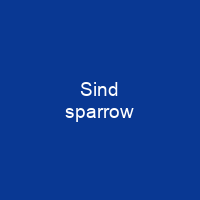The Sind sparrow is a passerine bird of the sparrow family, Passeridae. It is found around the Indus valley region in South Asia. The male has a chestnut stripe running down its head behind the eye, and the female has a darker head.
About Sind sparrow in brief

The female Dead Sea sparrow of the subspecies Passer moabiticus yattii is also similar, but has yellow tinges on the underparts and sometimes on parts of the head. The bill is black on the breeding male and pale brown on the non-breeding male and female. With a culmen length of 1. 1–1. 3 centimetres, the Sind sp arrow is slightly smaller-billed than the house sparrow. It has a grey crown and nape and a rufous lower back and rump. Wingspans range from 6. 2 to 7. 0 cm, tails from 4. 7 to 5. 7 cm, and tarsi measure 1. 6– 1. 9 centimetre. The Sind sp Arrow is 13 cm long, while the common South Asian subspecies of the house Sparrow,Passer domesticus indicus, is 15 cm long. The bird is social while feeding and gathers in small groups both while breeding and during winter dispersal. It was first formally described by Edward Blyth, from a specimen collected by Alexander Burnes at Bahawalpur in around 1840.
You want to know more about Sind sparrow?
This page is based on the article Sind sparrow published in Wikipedia (as of Nov. 08, 2020) and was automatically summarized using artificial intelligence.







